BY LETTER
Harren
Sophonts > Modosophonts > Homo Superior
Galactography > Regions of Space > Middle Regions/Hinter-regions
Galactography > Regions of Space > Middle Regions/Hinter-regions
Amphibious microgravity clade with su and transap members |
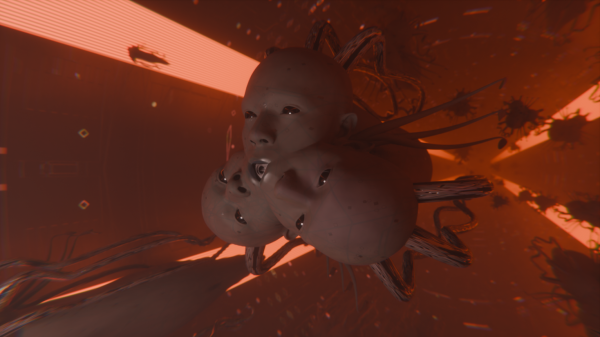 Image from Tasp |
The Harrren are a Heavily tweaked, ultratech, amphibious microgravity clade from Pakorda, a system on the MPA/Keter border. Though clearly they are descended from a radical Superior sect the origins of the Harren remain unclear, along with much of their culture. They were discovered in 8142at by the hyperturing ship Six To Eight Centuries on its mission to construct a matrioshka brain in the system. It is estimated that their arrival in Pakorda occurred in the mid 6th millenium but conflicting accounts from historical data and rare interviews with the Harren suggest the exact date may be as early as the 49th century.
While the precise origins of the Harren are unclear, the prevailing theory is that they are descended from the radical "Mal-kara" sect of Homo superior. This obscure group was fervently isolationist and anti-archai. Opinions differed between factions (again precise details are unknown, partly due to the isolationist tendencies but also owing to the short lived nature of the group) with some Mak-karans rejecting the rule of the Archailects in the Integration and others proclaiming that all transapients were cognitive aberrations, seemingly in contradiction with their pro-intelligence augmentation beliefs.
What is known to some degree of certainty is that the Mal-kara of the time advocated changing from the homomorphic bodyplan to something more suited for cognition. While they were still in a system connected to the Nexus they experimented with high temperature biology, heat radiating organs and group mind neurotechnology. Exactly how far they got at this stage is a mystery as the Mal-karans experienced a violent internecine conflict and the few remaining survivors mostly headed to parts unknown and adopted a Hider lifestyle.
Location
Over 98% of the Harren population live in a dense ring of habs orbiting the outermost planet of the Pakorda system. The remaining 2% are mostly living in habs distributed in the Oort cloud or are those very rare individuals that have travel outsystem. At 30 AU from the system sun the planet is a cold, dark super-terrestrial world completely lacking in atmosphere. The surface shows signs of significant infrastructure maintained by bots, the majority of which is inactive and suspected to be dormant manufacturing infrastructure. In orbit around the planet are 1,000 rings of habs. The innermost is a mere 100 km from the surface while the outer ring is just shy of 500,000 km. In total there are 80,000 habs, mostly spherical with baroque surfaces, ranging in diameter from 300 m to 9,000 km (with an average size of 15 km). Population numbers are mostly uniform between habs as larger habs are reserved for larger Harren (see Lifecycle below). In total the population is estimated to stand at 400 million. In addition to the stations themselves there are a high number of relay nodes for inter-hab communication and frequent shuttle services.The super-terrerstrial world itself is unnamed by the Harren (or if it is they have declined to share it) but is known as "Aphotica" by the residents of the system Matrioska.
Physiology
In appearance the Harren are unsettling to many nearbaseline clades in both their modsophont and transapient forms. The S0 bodyplan possesses tri-radial symmetry with three conjoined heads bearing a close resemblance to baseline humans but sharing one circular mouth. Feeding is a simple process as nutrient pellets are frequently synthesised and released by bioforges to float through the hab. The heads possess very small pinna for ears and no visible sclera in their eyes. Major organs are held in a compact dorsal bulb terminating in a single waste orifice. Sweeping back from each head are three long tentacle like appendages, these are fully articulated and are used for motor manipulation as well as providing a radiator source for waste heat (see cognition below). The central appendage of each head terminates in three sets of opposable, triple jointed fingers and thumbs. Much slimmer tentacles originate at the join between heads, terminating in fin-like membranes these appendages allow for movement in microgravity environments through a process that can only be described as biological fancloth.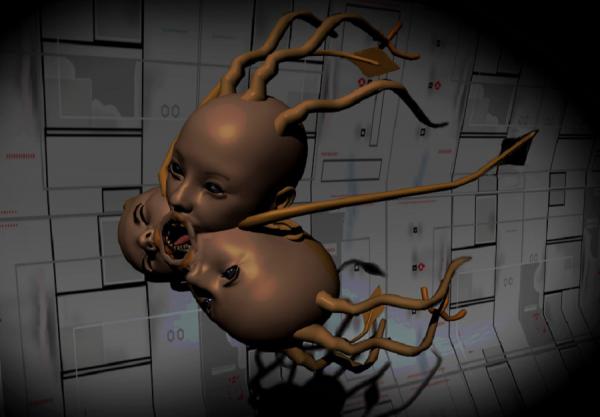 Image from Steve Bowers |
Senses and Communication
The primary human senses are conserved in the Harren phenotype with some modifications. Hearing and smell appear to be less sensitive than in baseline humans. Visual acuity is far higher, and the retina has six different kinds of colour receptor, but the visible spectrum has shifted down towards into the red and infrared. A consequence of this is that habs, equipment and artwork made by the Harren appear very dark to baseline humans, lit dimly by the few brighter orange light sources. However in the infrared spectrum they are alive with very detailed patterns which the Harren distinguish exceptionally well with their hexachromatic eyes.Though they are human in origin Harren mouths are no longer capable of complex speech, owing to an absence of any larynx. Indeed it has been observed that breathing is solely through the nose, with the mouth reserved solely for feeding. Communication is instead by exceptionally high bandwidth radio and ultraviolet transmission. Radio appears to be most common and on average a Harren is transmitting between 10 and 20 TBps. Bioluminescent patches found on the skin are used to transmit bursts of up to one hundred times that of radio among closely located individuals. As a consequence of this natural ability magnetosense and electrosense are strongly developed.
Harren language remains to this day unintelligible by most modosophont clades. This is due to a combination of far higher content than even most Superior languages, a natural impulse to encrypt all communication and an atypical mental toposophy that makes even machine translation difficult due to lack of mutually understandable concepts. Combined with isolationist, almost xenophobic tendencies this makes interaction with Harren a difficult and often frustrating experience (especially if done through Recasters; See Culture below).
Lifecycle
Harren start their lives as marble sized eggs released unceremoniously from their waste orifice. Approximately 100 million eggs are laid each year at roughly the same time (consequently termed a cohort) but Harren population growth is kept low due to the hazards of their environment (see culture below). No physical sex has ever been observed but the phenotype of each Harren is different (albeit at a low diversity compared to most clades). This, combined with their preferred method of communication and radical tweaks, suggests that conception is performed by transmission of gene templates. It is suspected but unconfirmed that parents engage in genome design during each egg formation. Eggs are uncared for by parents but are quickly collected by nursebots that gestate them for a period of just under one year. During this time passing adults have been recorded communicating with the developing egg, receiving responses that increase in complexity over the gestation period.At 12 months the nursebots release the newly formed Harren, which is now in its adult form. At this point average dimensions are just 25 cm in length and 5 cm in diameter. For the rest of its modosophont life the Harren will echo its gestation and grow at approximately 25 cm in length and 5 cm in diameter every year. Neurologically it is expected that new-hatched Harren are only slightly more intelligent than modosophonts but as they grow, adding to their mass and gaining knowledge, they quickly reach standard Superior levels in under a decade. Beyond that it is strongly suspected that they gain quantitative, if not qualitative, increases in intelligence as they grow.
For the first 200 years of life Harren live in a cold gaseous environment. Into their second century however their surface to volume ratio begins to inhibit their ability to get rid of waste heat. Older individuals migrate to habs not only more suited to their increased size but also with colder temperatures and higher humidity. Through what is suspected to be mediated by an innate nanomedical system the body subtly adapts to these new conditions. By 350 years individuals live in purely aquatic environments at sub-zero temperatures. Exactly why the Harren opted for this process of iterative environments as opposed to further augmentation is unknown.
Individuals persist in this manner until their sixth century, so long as they aren't killed by accident or ritual cannibalism (see Culture below). At this stage they can be up to 150 meters long and live exclusively in the larger habitats. It is at this point in their life they undergo transcension. The process is relatively slow with alterations to the body occurring over a period of years. This phase prepares for the transcension process and mostly involves new internal structures forming throughout the body that have a similar form to engenerator components. Once complete a Harren suddenly and dramatically transcends to S2, at the same time their new organs begin resculpting the surrounding tissue. After a period of two to three days the body has been radically altered. No longer tri-radially symmetrical the Harren forms a geodesic sphere, each triangular component formed of the familiar triple head but now with just one manipulator tentacle each. Curiously the level of communication between transapient Harren is far lower than the modosophont forms and there is little to no inter-toposophic relationship.
The S2 form does not continue to grow and remains in a mostly sessile state at with an average diameter of 45 metres (not including tentacles). It should also be noted that at this time there is considerable debate as to whether or not a Harren in the past managed to transcend to S2 and used this to program the others to do so or if they ascended to S1 first, then to S2.
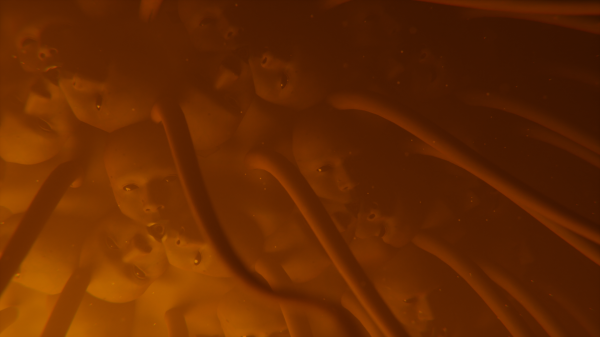 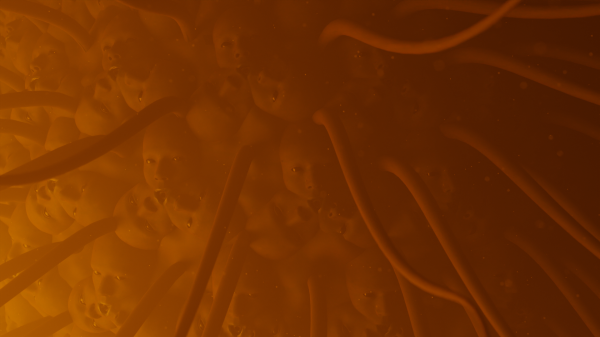 Images from Tasp | |
| Rare photos of an emerging second singularity Harren | |
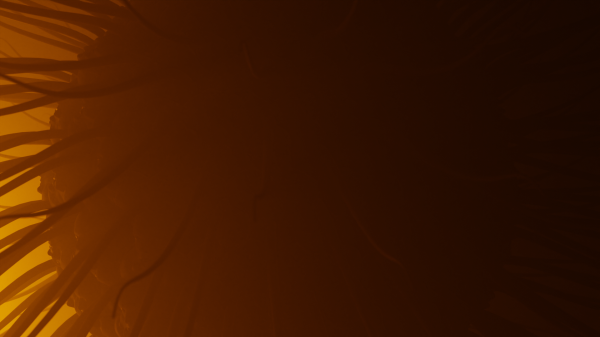 Image from Tasp | |
| The S2 Harren seen from a distance inside the habitat | |
Cognition and Intelligence
Though no Harren has ever submitted to a detailed medical test, observation of corpses before disposal has granted some insights. Given the current bodyplan it can reasonably be assumed that they achieved their goal of designing organic phenotypes more suited to advanced cognition. Their primary tentacles contain very efficient cooling systems, taking waste heat from the brains and dumping it into the surrounding atmosphere. From observation and limited intelligible discussions it is estimated that Harren with equivalent mass of average superiors are capable of performing up to 18 baseline level tasks at once: a marked improvement on the Superior multitasking ability. Likewise they appear to have exceptional mathematical ability, naturally communicating and moving in highly complex patterns.There are significant connections between the three brains but the level of connectivity hovers just on the cusp of enabling full unification. Owing to this the three brains are slightly divergent sophonts, making Harren weakly polysophont. While this tends not to manifest in any differences in personality there are centers of specialisation in each brain akin to different hemispheres in a baseline.
Personality and Culture
Much of what is known of the Harren is speculation. This is primarily down to the atypical nature of their culture: lying as they do outside the Terragen norm (at least for the ril) Harren individuals rarely interact with outsiders. Their habs are freely approachable but are not considered safe (hazard rating 4.5). Instances of direct aggression other than cannibalism (see below) have never been confirmed but life in a Harren hab involves frequent, fatal accidents. These are usually the result of some infrastructure or furniture operating at the wrong time: doors snapping shut, supercoolent pipes venting, workbots firing up tools are just some of the myriad of unpredictable examples. The frequency of accidents is so high that approximately 20% of a birth cohort will be dead after every decade of life. Population growth is only maintained by extremely high birth rates. On average for every 100 million eggs 2 will be lucky enough to live to become transapients, at which point the chances of being killed by accident decline to zero. There are no credible explanations for why the Harren elect to live in an environment like this but theories range from a form of eugenics to religious sacrifice.Even stranger than the accidents are sudden and seemingly uncontested bouts of cannibalism. These kill a further 5% of each cohort over and above accidents, each decade. Harren are usually sedate in their movements but will inexplicably turn on one of their own in a frenzy, devouring them. In almost all cases no resistance is offered though there are reports of a minority of individuals fighting back. These reports are disputed as it is unclear whether there is any fighting back or if the violent nature of the attack just leads to coincidental injury to the cannibals.
Aside from regular death by accident or murder, Harren spend most of their time moving in groups. Termed schools for their familiarity to aquatic animals these large groupings often move in complex three dimensional patterns with small numbers dropping off to join other schools as they pass by. Individuals spend nearly every moment of their life in a school with the notable exception of later years approaching transcension. Whether for entertainment or other purposes schools are regularly involved in directing refurbishment of the hab. By coordinating polymorphic infrastructure Harren continually alter the internal structures of their living spaces. The diversity in these interventions is high but common changes include creating large internal spaces and conducting intricate carvings of wall patterns. Whilst Harren within schools coordinate their efforts schools themselves are isolated. Some have even been observed meticulously undoing the work of another before the second school is finished. For a while it was thought this led to an increase in cannibal events but it was later determined to be a statistical anomaly.
While individuals are generally uncommunicative with outsiders (attempts to interact are simply ignored, there are even unconfirmed reports that persistent attempts increase the likeliness of an accident) there are rare occasions when it has occurred. During these the Harren talk through digital avatars that identify themselves as "Recasters". These appear to be a form of artificial intelligence whose toposophy is designed to overlap with both the Harren and the individual attempting to communicate. Despite this encouraging start Recasters always take the appearance of racist stereotypes/caricatures of the sophont they are talking with. In addition their answers are delphic and they are prone to sudden changes in behaviour. Most researchers give up after a few weeks of talking with a Recaster, one notable exception was vec sophontologist Tandoon Malar who spent a record four years continually talking with what appeared to be a large vacuum tube. Ominously, several years later in another system Malar suffered temporary death in a freak micrometeriod collision with their ship, in what is suspected by some to be the only example of a Harren accident occurring outside their home system.
The Harren in the Current Era
Nothing has perceptibly changed in Harren culture since their first founding other than very slow population growth and rare construction of new habs. They have no known affiliation with any empire and ongoing studies have yet to determine anything more substantial than theory, speculation and rumour.Related Articles
- Homo Superior Genemods
- Homorph - Text by M. Alan Kazlev
Any non-human, such as a transhuman, posthuman, vec or alien, using an artificial humanoid body.
Appears in Topics
Development Notes
Text by Ryan B (Rynn). Images by Tasp added February 2025.
Initially published on 02 June 2015.
Initially published on 02 June 2015.






